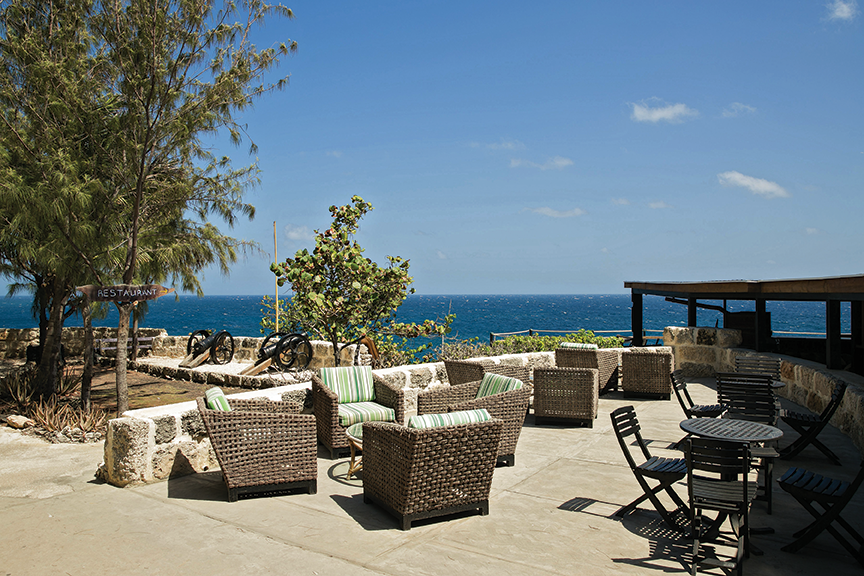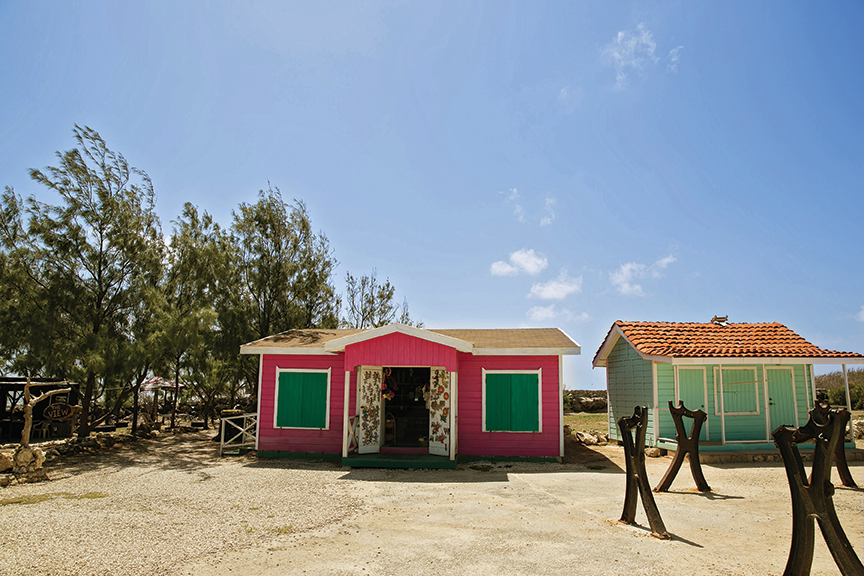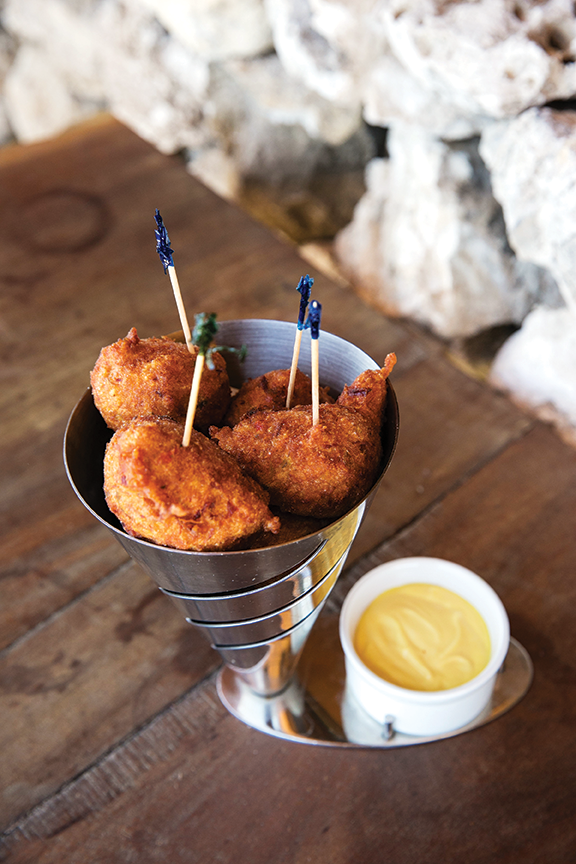Dining in Coral: A Delicious Barbadian History Lesson with a View
Manuel Ward
Owner – Animal Flower Cave and Restaurant
Manuel (Mannie) Ward, the third-generation owner of the Animal Flower Cave and Restaurant, seems relaxed. He’s sitting in a comfortable chair near his outdoor bar on a hot Barbados afternoon.
— By Amie Watson
— Photography: Kenneth Theysen
But even while taking a break from running the kitchen at one of the country’s most popular tourist destinations, he’s busy listening. He wants to know if visitors enjoyed their thick-cut Bajan ham cutters, chicken and potato roti, and seacat (local octopus) and conch salads with organic greens. Was the bread flaky enough? Did the kids like their ice cream? Are they looking for the playground?
“Next right turn, guys!” Ward hollers across the shaded seating area, interrupting the otherwise gentle, melodic cadence of his voice. He means the staircase that descends to the Animal Flower Cave below, but only the woman who thanks him and walks toward the stairs knew what unasked question he was answering with such a helpful bellow. As a third-generation Barbadian, Ward is an encyclopedia of local history and culture. He also runs a tight and friendly ship thanks to a background in fine dining, turning what could have been just a panoramic pit stop on a tourist’s itinerary into a dining destination.
As Ward’s voice re-establishes its rhythm and tone, he launches into the history of the Animal Flower Cave, his stunning restaurant and some of Barbados’ most famous food traditions.
How did you come to own the Animal Flower Cave?
My father’s family started off with an Irish indentured servant sent here by England in 1681. My granddad first built a bar here in 1927. That got destroyed in Hurricane Janet in 1955, so my father built the new bar, in 1960, on the same spot. Two years ago, I tore it down to build this new kitchen and bar and added the dining room overlooking the cliffs. It took a year and I opened in 2015. My wife Sue and son Mitch work with me, and our two youngest, Bella and Mimi, help out on the weekends for pocket money.
Did you have a background in restaurants?
I’ve spent at least thirty-five years working in different high-end restaurants in Barbados: The Cliff, Sandy Lane, Mullins, La Maison, which is now called The Tides. People were always asking where they could eat local food. So I knew, when I opened my own restaurant, that I wanted something low-key – local food but nicely presented.
The view from the cliff-side restaurant is almost as breathtaking as the one from the Animal Flower Cave lookout below. How did you design the restaurant to enhance the experience?
All the rocks are coral stone on the inside of the restaurant and cliff stone on the outside. It looks like an old Barbadian home, because originally the coral was cut into big blocks and used in old buildings, which is where I got them. Up here by the bar, I used repurposed Canadian pine from an old wharf, because all the hardwood trees in Barbados were cut down to make room for coffee and other plants that didn’t work, before the sugar plantations were started. On the wall are ballast bricks from 17th C. and 18th C. sailing boats. When they sailed across from Europe, they wouldn’t have much cargo, so they’d put these into the ship for weight. Once they’d get to Barbados or other Caribbean islands, they’d offload and then load up with sugar, molasses and rum. A lot of the leftover bricks were used for making chimneys in the sugar factories.
Any Swashbuckling stories about them?
These bricks are all from Scotland, except two that are French. I know there were lots of them in Martinique and Guadeloupe, which makes sense because those islands were mostly French. But Barbados was always an English colony, and France and England were enemies throughout that era, so the only way those bricks would have come here is if they came off a French ship captured by the British.
Weekday lunches bring a steady flow of tour groups and other travellers for sandwiches, salads and grilled fish, but weekends bring more locals and more elaborate fare – anything from traditional curry goat to melon and Prosecco soup, filet mignon with thyme-lemongrass jus, and mango and passion fruit crème brûlée. How did you build your reputation
with locals?
People knew me from my years in the industry, and in the beginning, they came and wrote about us on social media, saying they’d had a great lunch at Animal Flower Cave. Then their friends came and tried it. We also have a Facebook page where we post the menu. On the weekend we have more cooked food – things that take longer to prepare, like lamb stew or chicken and shrimp specials with baked potatoes, sweet potato mash or basmati rice and vegetables.
How did you end up hosting a rave?
We’d just opened and these two guys came up and loved the location and said they wanted to have a rave here. They had their own bar, DJ, lights, staff and security. They cleaned up and handed it back to me by 7 a.m. the next morning. We’re a lunch-only restaurant, so it was great. This year we’ve done three weddings, two birthday parties and a rave.
Barbados has a lot of traditional foods, including buljol and cou-cou. What are their stories?
Back in the 16th and 17th centuries, Barbados used to ship molasses, sugar and rum to Nova Scotia, Canada and bring back ice. When someone at the north part of the island saw the ice boat coming, they’d ride their horse back into town and tell everyone, so people could send out their invitations – because all the parties would happen within the next three days, before the ice melted. On that boat would also come salted cod, pork and meat, which were considered poor man’s food and were eaten by slaves. With the salted cod they’d make fish cakes and buljol, a shredded salt cod salad. They made another dish called cou-cou, where they boiled okra and added cornmeal until it came out a kind of polenta. Then they would make the salt cod into a gravy to go over top.
Chicken liver cutters?
Growing up here, there were bars you’d go to at 3 a.m. after the nightclub because you were piss drunk and needed something to soak up the alcohol. A cutter is a sandwich made with a bun instead of bread and you put whatever you want in there – ham, cheese, fish, chicken liver. And there’s a place called The Red Star down in Bridgetown that used to sell chicken liver cutters. So when we did the menu, I said we have to have a liver cutter. I don’t even like liver! But if we’re representing our cuisine, we have to have it. I’m also the only one in Barbados doing a liver and potato roti. We stew the liver with spices, herbs and gravy for the sandwich and roti, or serve it in a side dish with salad.
Pickled seacat and conch?
Pickled seacat and conch is made the same way we make our pickled pork and is related to English souse. But when we say pickled, we mean fresh lime juice, not pickled like cucumber pickles. We stir the conch and seacat, which is local octopus, and shelled local sea snails, with parsley, cucumber and a bit of bonney pepper – scotch bonnet – and serve it cool. That’s traditionally prepared every Saturday in Barbados with pickled pig, pickled green banana and sweet potato. The octopus is even local. I have a guy who brought me
15 pounds two days ago.









